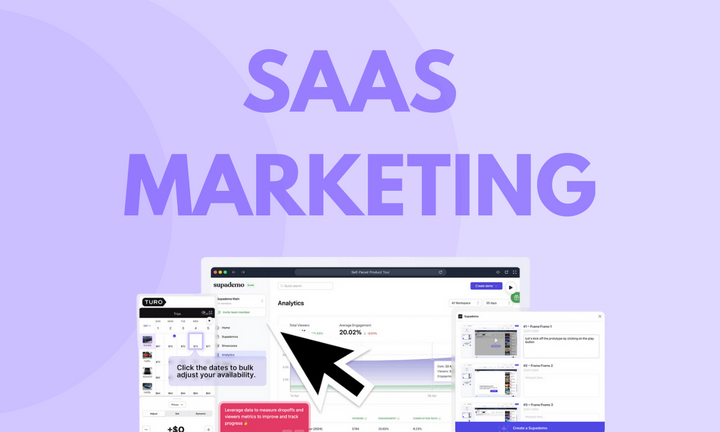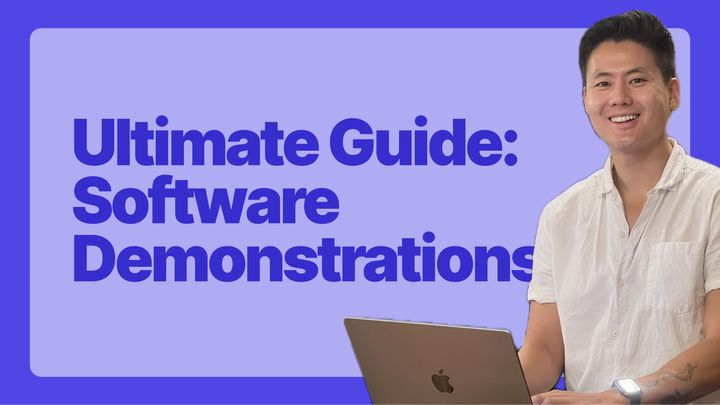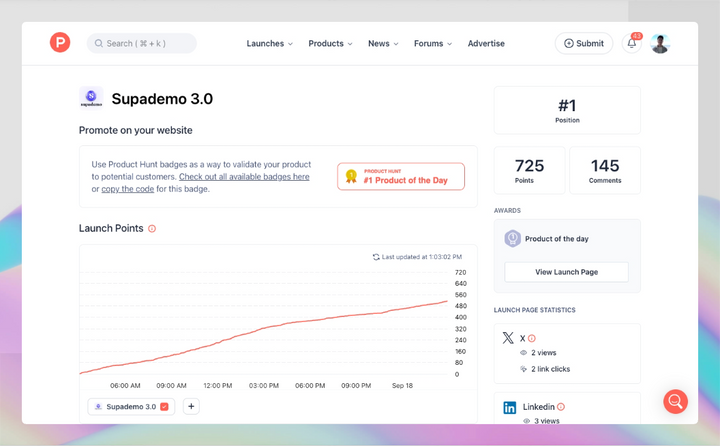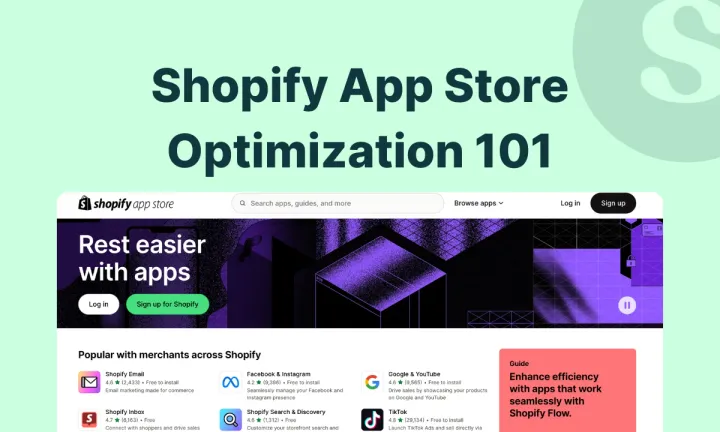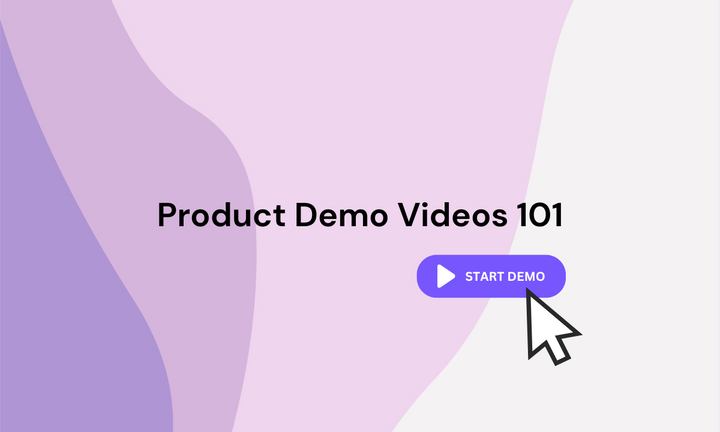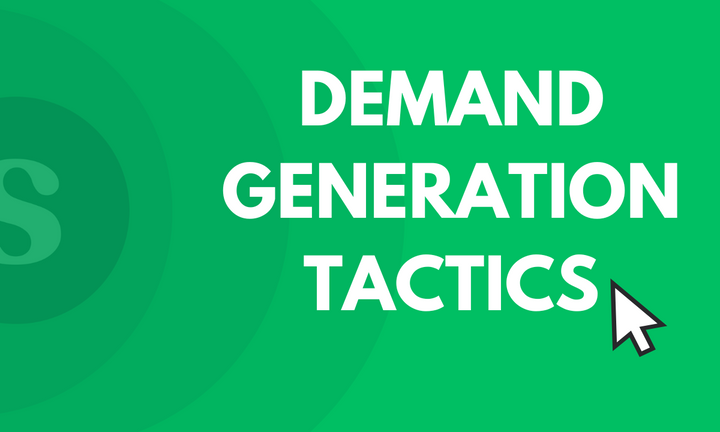SaaS marketing can be tricky. But don't worry, we've got your back.
In this guide, we'll show you how to boost your SaaS marketing game for 2025 (and beyond). We've talked to experts, dug into our own experience, and put together strategies that work.
Take Dropbox, for example. They used a simple referral program, and boom – 3900% more users in 15 months 😱📈

That's the kind of smart thinking we'll explore here.
Whether you're just starting out or looking to level up, you'll find practical tips to increase signups and sales. We'll cover everything from content marketing to keeping your customers happy.
What is SaaS marketing?
We’re all familiar with the basics of SaaS product marketing, such as attracting users to a SaaS product with a subscription business model. That said, there are key differences between a SaaS marketing strategy and standard digital marketing.
Unlike traditional software marketing, SaaS marketing often emphasizes ongoing value, ease of use, and subscription benefits. The goal is not just to sell a product but to create long-term relationships with customers who will continue to use and pay for the service.
Having a clear SaaS marketing plan is essential to landing new users, keeping the customers you already have, and increasing their lifetime value over time.
SaaS marketing is evolving as the buyer’s journey becomes increasingly nonlinear. Traditional funnels assume a straight path from awareness to conversion, but in reality, buyers navigate multiple touchpoints—organic search, ads, competitor research, and social media—before making a decision. They may drop off, revisit, or reconsider based on various influences.
This shift means SaaS marketers must move beyond linear campaigns and embrace a multi-touch, always-on strategy. Retargeting, personalized engagement, and interactive demos are now essential to guiding prospects through a fragmented decision-making process, ensuring they stay engaged despite the twists and turns of modern B2B buying.

In this guide, we will highlight some of the nuances of modern SaaS marketing, walk you through its various components, and teach you how to create effective strategies.
TL;DR
- SaaS marketing is the process of launching a product, building awareness, landing customers, retaining them, and increasing their lifetime value.
- SaaS marketing requires an effective retention strategy as the majority of a customer’s lifetime value is dependent on them renewing their subscription.
- Your SaaS marketing plan should factor in all five stages: attracting leads, nurturing leads, retaining customers, enhancing revenue, and tracking performance.
- Creating an effective SaaS marketing campaign will come down to identifying your audience, positioning your product, finding the right channels, using relevant KPIs, and adhering to best practices.

A few product marketing strategies you can try include:
- Using content marketing to lower acquisition costs.
- Leveraging interactive product demos to let prospects try your product without a demo call, subscription, or paywall.
- Increasing signups with a free trial or freemium plan.
- Personalizing the user experience with personalized demos.
- Offering self-service support and async onboarding options.
- Gamifying onboarding.
- Leveraging video content.
- Proactively addressing customer needs.
- Building a community.
- Creating a referral program to drive word-of-mouth marketing.
How is SaaS marketing different from digital marketing and every other type of marketing?
SaaS marketing stands out in several key ways:
- Free trials: Unlike physical products, SaaS companies often give away their full product for free trials. This strategy helps users experience the value firsthand.

- Rapid sales cycles: SaaS purchases can happen in days or even hours, not months. Customers research, try, and buy quickly.
When [SaaS customers] need a solution, they do some online research, maybe ask a colleague, try the solution or watch a demo, and then buy. The whole process might take a few days, maybe a few hours. There’s no long, drawn out sales engagements, RFIs and RFPs, head-to-head “bake-offs,” contract negotiations, blah, blah, blah. Customers find it, they see it, they like it, they buy it. Done.
- Peter Cohen, SaaS Marketing Strategy
- Information is king: Content marketing is crucial. SaaS companies often become go-to sources of industry knowledge.
- Long-term focus: Customer retention is vital. Most revenue comes from existing users, not new acquisitions. SaaS products are often offered on a subscription model, meaning retention is just as important as acquisition (if not more important). In addition to generating leads, a SaaS marketing strategy should also seek to educate potential customers on the value proposition of the product.
- Service over product: While the software matters, ongoing service and support are equally important for success.
“When creating your SaaS marketing plan, you must understand that your business model of choice is a fully-integrated architecture where all aspects of the business — product, support, revenue model, and marketing — are tightly-coupled.”
- Lincoln Murphy
- Self-service model: Many SaaS products are designed for users to buy and use without extensive sales involvement.

These differences shape how SaaS companies approach marketing, focusing on education, quick value demonstration, and building lasting relationships.

Another notable difference is that a sizeable percentage of SaaS marketing efforts occur inside the product itself while traditional digital marketing relies heavily on external channels such as organic social media or paid ad campaigns to reach customers.
What you include in your SaaS marketing playbook will depend on who your customers are. Account-based marketing is the preferred approach for enterprise solutions, while software bundles often leverage email marketing to generate sales.
What are the different components of SaaS marketing?
A typical SaaS marketing strategy unfolds across five key phases:
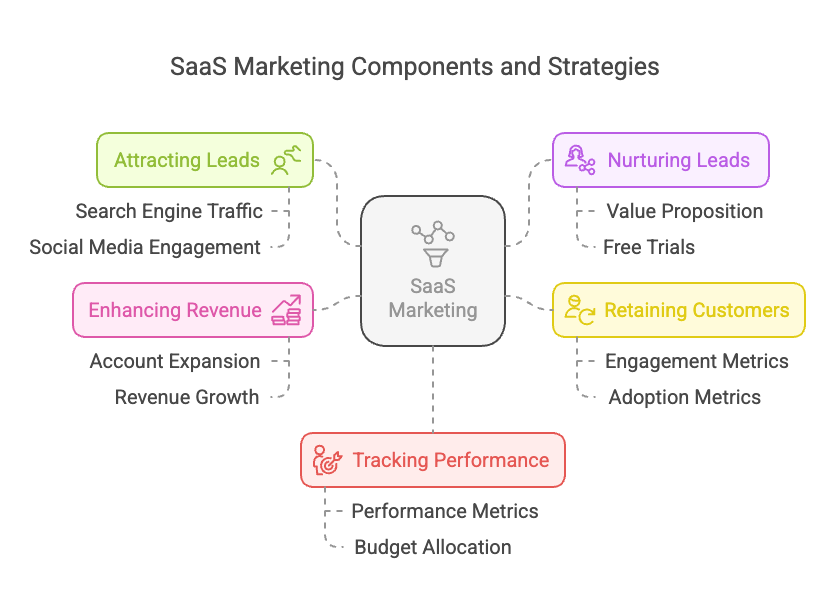
1. Lead Generation
Begin by attracting qualified prospects who match your ideal customer profile. Focus on creating visibility through search engine optimization and strategic social media presence to draw in potential customers actively seeking solutions like yours. You can leverage the power of a digital marketing agency directory to connect with professionals experienced in reaching your target audience.
2. Lead Development
Once prospects engage with your brand, guide them through a carefully designed nurturing process. Help them understand your product's unique value proposition and encourage them to take the next step, whether that's starting a free trial or becoming a paying customer.
3. Customer Retention
Since SaaS revenue primarily comes from ongoing subscriptions rather than initial sales, prioritize long-term customer relationships. Monitor key engagement metrics and actively support product adoption to maintain strong retention rates. Prioritizing key engagement and adoption metrics is important to successful retention.
4. Growth Optimization
Look for opportunities to expand revenue from your existing customer base. This might include encouraging upgrades to higher-tier plans, adding more users, or adopting additional features and services.
5. Performance Analysis
Implement robust tracking systems to measure the effectiveness of your marketing initiatives. Use these insights to make data-driven decisions about budget allocation and strategy refinement for maximum return on investment.
How To Create an Effective SaaS Marketing Strategy
Let's explore the six essential steps for developing an effective SaaS marketing strategy that will drive growth and customer engagement for your product. This comprehensive guide will help you build a strategic framework that delivers measurable results.
1. Define Your Target Market Through Research-Based Personas
The foundation of effective SaaS marketing lies in developing a deep understanding of your ideal customers through carefully constructed personas. Start by analyzing your existing customer base to identify patterns and commonalities that can inform your targeting strategy.
Understanding your current successful customers provides valuable insights for both retention and acquisition. Consider implementing detailed customer surveys to gather comprehensive data about your users, which will help shape future marketing initiatives.
For the most comprehensive understanding, integrate both quantitative and qualitative research methods:
Quantitative Insights
Gather concrete, measurable data about your customers including:
- Demographic details such as age, gender, education, location, and professional background
- Market statistics from authoritative sources and industry databases
However, while demographic data provides useful context, it's the qualitative insights that reveal deeper understanding of customer behavior and needs.
Qualitative Understanding
Collect rich, descriptive data through:
- In-depth customer surveys exploring motivations and challenges
- One-on-one interviews with current users
- Structured focus group discussions to uncover shared experiences and needs
This combined approach helps create detailed, actionable personas that reflect not just who your customers are, but why they choose and continue to use your solution.
2. Define your positioning and messaging
The next crucial step is developing your product's market position and crafting compelling messages that support it. A strong positioning strategy helps distinguish your offering by highlighting its distinctive advantages and demonstrating why customers should choose it over competing solutions.
When you create focused messaging that clearly articulates your product's key benefits, you can effectively reach and persuade potential buyers.
Since your positioning and messaging need to work together seamlessly, it's essential to develop them in parallel to maintain consistency across all customer communications.

3. Choose marketing channels
After establishing your target market and positioning, the next step is determining which marketing channels will best attract new customers. Consider these effective options for SaaS marketing:
- Direct Product Engagement Build relationships with users through strategic in-app product messaging while they actively engage with your solution. This creates highly relevant touchpoints during the user experience.
- Strategic Content Development Create valuable content that addresses your audience's needs and challenges. High-quality blog posts and articles can generate significant organic traffic from qualified prospects searching for solutions.
- Search Visibility Enhancement Implement comprehensive SEO practices to improve your content's visibility in search results. This complements your content strategy by helping potential customers discover your solution when researching options.
- Email Marketing Despite newer marketing channels, email remains valuable for SaaS companies. Targeted email campaigns can nurture leads and maintain engagement throughout the customer journey.
- Social Platform Presence Maintain active social media profiles since many buyers evaluate SaaS solutions through their social presence. Regular engagement helps build credibility and connect with potential customers.
- Targeted Advertising While potentially costly, strategic use of pay-per-click advertising can accelerate market presence and support content promotion. Consider testing paid campaigns to reach specific audience segments.
- Influencer Marketing with relevant influencers to expand reach across platforms and tap into established audiences. Their credibility can help build trust with potential customers.
- Customer Advocacy Programs Implement referral systems that reward existing customers for recommendations. This leverages satisfied users to generate qualified leads through trusted word-of-mouth marketing.
4. Establish Key Performance Indicators for Marketing Success
Implementing robust measurement systems is essential to evaluate your marketing initiatives' effectiveness and return on investment. Your specific success metrics should align with your campaign objectives and overall business goals.
Consider tracking these critical metrics to gauge performance:
| Metric | Description |
|---|---|
| Customer Acquisition Cost | Track the cost of acquiring each customer (CAC) relative to their lifetime value. This helps ensure your marketing spend maintains healthy profit margins and sustainable growth. |
| Long-term Customer Value | Monitor how customer lifetime value (LTV) evolves over time to assess the impact of your retention and expansion strategies. Rising LTV often indicates successful customer relationship management. |
| Free Trial Performance | Analyze the percentage of trial users who convert to paying customers. This metric reveals the effectiveness of your onboarding process and initial value delivery. |
| Customer Loyalty Measurement | Keep close watch on retention rates as they directly reflect customer satisfaction and ongoing product value. Strong retention indicates sustained product-market fit and customer success. |
| Revenue Growth Patterns | Track monthly recurring revenue (MRR) trends to identify potential issues with market fit, customer retention, or pricing strategy. Even when marketing impacts aren't immediate, MRR provides valuable insights into overall business health. |
| Customer Attrition Analysis | Focus on reducing customer churn, as retaining existing customers typically costs less than acquiring new ones. High churn rates may signal problems with product value or customer experience. |
| Referral Likelihood | Use Net Promoter Score (NPS) to understand customer advocacy potential and likelihood of word-of-mouth growth. Strong NPS scores often correlate with sustainable business expansion. |
| Satisfaction Monitoring | Implement Customer Satisfaction Score (CSAT) tracking to maintain pulse on user happiness and identify areas needing improvement. Regular satisfaction measurement helps prevent customer attrition. |
5. Develop your SaaS marketing strategies
After establishing your marketing channels and success metrics, develop specific tactical approaches for your campaigns. Consider implementing these proven strategies to maximize your SaaS marketing effectiveness:
- Emphasize your product's core value by letting potential customers experience its benefits directly. This product-led approach can significantly reduce your customer acquisition expenses while demonstrating real value.
- Every piece of content should guide readers toward meaningful action through strategically placed, compelling calls-to-action. This ensures your content not only informs but also drives engagement.
- Keep users informed and engaged by highlighting new features through targeted in-app messaging. This helps users discover and adopt capabilities that add value to their experience.
- Create systematic ways to collect and analyze user feedback. Understanding user experiences and preferences enables continuous improvement of both product and marketing efforts.
- Develop comprehensive self-help resources that empower users to find solutions independently. This enhances user satisfaction while reducing support costs.
- Adding interactive product demos and micro videos to onboarding flows.
- Gamifying and personalizing the onboarding experience like the example below:
6. Optimize Marketing Performance Through Continuous Analysis
Success in SaaS marketing requires an iterative approach to improvement and refinement. Beyond tracking your established key performance indicators, incorporate objectives and key results (OKRs) into your evaluation framework.
This dual measurement approach helps ensure your marketing initiatives both deliver immediate results and progress toward longer-term strategic goals.
Regular assessment of both metrics and OKRs enables you to:
- Make data-driven adjustments to campaigns
- Identify and scale successful strategies
- Quickly address underperforming initiatives
- Maintain alignment between marketing activities and business objectives
Advanced SaaS marketing tips to boost your growth
Now, let's look at some more strategies you can implement to grow your SaaS business.
1. Build a community
A strong community can be your SaaS brand's secret weapon. From day one, focus on nurturing this asset. Whether you start with a handful of enthusiasts or thousands, the strength lies in your core members.
Community building isn't just about numbers. It's about creating a space where passion for SaaS thrives.
Building a community takes time and effort, but the rewards are substantial. It can boost brand loyalty, provide valuable feedback, and even spark new ideas for your product. In the SaaS world, your community can be your biggest asset for sustainable growth.
2. Remove barriers to sign-up
Let's bust a myth: "qualification barriers" or requiring credit cards for free trials don't create better customers. They just create fewer customers, period.
The data speaks volumes. Reducing fields on your sign-up form can dramatically boost your conversion rates. It's not about gatekeeping; it's about opening doors.
Consider and learn from the smart moves of successful SaaS companies.
Dropbox: Just an email to get started.

Why does this work? It's simple psychology. Every extra field is another chance for a potential user to think, "Do I really need this?" and bounce. By keeping it simple, you're saying, "Come on in, the water's fine!"
Remember, you can always gather more information later. The goal of your sign-up process should be just that - to get people to sign up. Save the detailed questions for when they're already experiencing your product's value.
In SaaS, your biggest enemy isn't unqualified leads. It's friction. So make your sign-up process smooth as silk, and watch your user base grow.
3. Invest in SaaS content marketing
Content marketing is a powerhouse for SaaS growth. Why? Because your potential customers are already searching for solutions to their problems online.
Key points to remember:
- Focus on outcomes, not features: Don't just list what your product does. Show how it solves problems and improves lives.
- Align with the buyer's journey: Create content that answers questions at each stage, from awareness to decision.
- Quality trumps quantity: Consistently produce high-quality, persona-driven content. It's not about how much, but how good.
- Optimize for search: Make your content easy to find. Use relevant keywords, but don't sacrifice readability.
- Be a thought leader: You know your customer's pain points. Use this knowledge to provide valuable insights.
- Offer value upfront: Consider gating premium content (like ebooks or webinars) in exchange for contact information.
- (Hyper) Personalize your approach: Tailor your messaging to specific industries or personas. One-size-fits-all rarely fits anyone well.
- Promote strategically: Use social media and other channels to amplify your content's reach.
Remember, effective SaaS content marketing isn't just about attracting leads—it's about nurturing them through the sales funnel. Your content should educate, engage, and ultimately convert.

By focusing on creating valuable, relevant content, you position your SaaS as the go-to solution in your niche. It's not just marketing; it's building relationships with your future customers.
4. Show, don't tell!
In the SaaS world, seeing is believing. That's where interactive demos come in, embodying the "show, don't tell" principle perfectly.

Interactive demos are game-changers in SaaS marketing. They let potential customers experience your product firsthand without the commitment of signing up.
Why are they so effective?
- Removes friction: Users can explore your product without the barrier of registration or installation.
- Provides real feel: Nothing beats hands-on experience. Users get a true sense of your interface and features.
- Boosts engagement: Interactive elements naturally draw people in, keeping them on your site longer.
- Accelerates decision-making: When users can see the value immediately, they're more likely to convert faster.
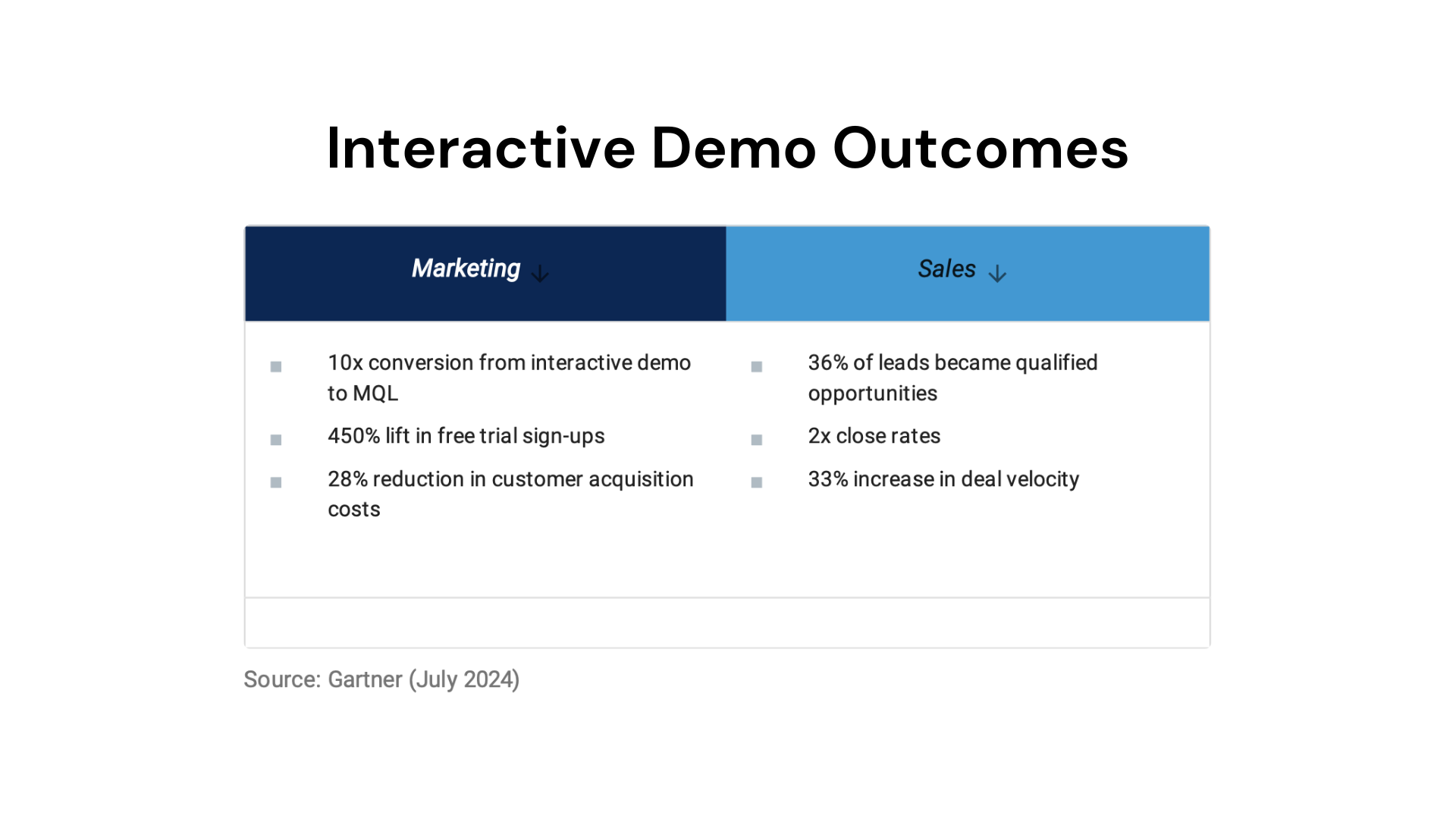
The beauty of interactive demos lies in their versatility. You can use them:
- On your homepage to grab attention
- In blog posts to illustrate points
- During sales outreach to showcase specific features
- In onboarding to familiarize new users

Some companies even create custom demo environments for different use cases or industries.
Remember, people retain information better when they're actively involved. An interactive demo turns passive observers into active participants.
By implementing interactive demos, you're not just telling potential customers about your product - you're letting them experience it. This hands-on approach can significantly reduce doubts and accelerate the path to purchase.
In a world where attention spans are short and competition is fierce, interactive demos give you an edge. They show confidence in your product and respect for your customer's time. It's a powerful way to say, "We know our product is great. Here, see for yourself."
Consider interactive demos in marketing
Interactive product demos are visual, guided demonstrations of your product's key features, benefits, and use cases.
Just like you'd explore and try on clothes in a clothing store before buying it, interactive demos create a virtual showroom for your products. Users can explore, interact, and navigate the product without paying for it.
Interactive demos can be a powerful tool in your marketing roadmap, launch, or day-to-day initiatives. For instance, it can:
- Create awareness and demand for your product
- Gather user feedback post-product launch
- Announce and showcase product updates
Ultimately, interactive demos help create engaging experiences that showcase the value your audience is looking for and also help them understand how your product is the solution to their pain points.

To get started, all you need to do is click here and start building demos for free, no credit card required.
But, your product marketing strategy is missing a key consideration.
- More than your landing page, buyers want to see the product in action.
- They want to test your product before they start working on the case to get buy-in.
- They need assurance that your product can solve their challenges by delivering the outcomes they’re hoping for.
Interactive product demos take care of these pain points. These demos reduce the gap between your product and buyers by giving them a frictionless way to experience its features in real time.


